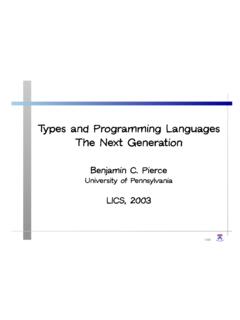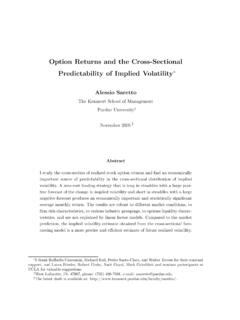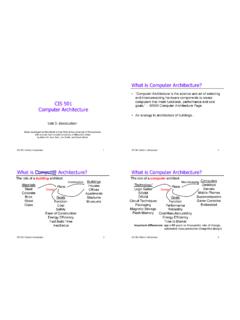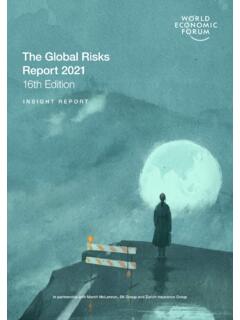Transcription of Carbon Offsets - University of Pennsylvania
1 Carbon Offsets An Overview for Scientific societies Richard Kim and Benjamin C. Pierce Version June 24, 2018 Executive summary Carbon Offsets are mechanisms allowing individuals and organizations to offset activities (such as air travel) that emit Carbon dioxide (CO 2 ) and other greenhouse gases by funding mitigating activities (such as landfill methane capture) elsewhere. For scientific societies , where air travel to conferences plays a central role in the organization s activities, Carbon Offsets offer an immediate response to the issue of climate change while longer-term, more comprehensive plans to reduce Carbon emissions are being developed.
2 The world of Carbon Offsets what kinds of Offsets are available, what organizations offer them, how they are vetted and evaluated, which ones are considered good, how much they should cost, etc. is rather complex, and there are arguments both in favor of and against purchasing them. This report is an attempt to summarize what we have learned about this world while developing recommendations for SIGPLAN , the Special Interest Group on Programming Languages of the Association for Computing Machinery , as part of a larger effort to evaluate potential ways for SIGPLAN to respond to the issue of climate change.
3 Our conclusion is that, on the whole, purchasing Carbon Offsets is a good short-term strategy for mitigating climate effects of conferences. Four basic criteria are commonly used to evaluate Carbon Offsets ( additionality, permanence, absence of leakage, and verification ), and several different standards (such as the Verified Carbon Standard , the Gold Standard , and the Clean Development Mechanism ) are used by vendors (such as atmosfair and Cool Effect ) to certify that particular Carbon -offset projects satisfy these criteria to an acceptable degree.
4 Types of offsetting projects range from renewable energy development and energy efficiency improvements to reducing Carbon emissions from industrial and agricultural processes and to biosequestration ( , planting trees), to deploying technologies for Carbon capture and storage. The Stockholm Environmental Institute (SEI) found that the types of projects most likely to deliver reliable greenhouse gas reduction while furthering (or at least not damaging) the United Nations Sustainable Development Goals (SDGs) were methane capture projects such as wastewater treatment, manure management, and landfill gas capture.
5 Offsets also vary widely in cost (from less than $1 USD to more than $50 USD), depending on project type, vendor, certifying standard, geographical region, and other factors. A typical cost for rigorously certified Offsets from reputable vendors is around $9 $15 USD per ton of CO 2 e ( CO 2 -equivalent, the standard unit of measure for greenhouse gases). Opinions vary about whether Carbon Offsets are a good idea at all. In particular, critics point out that the convenience and inexpensiveness of Offsets may lead organizations to delay challenging conversations about how to actually reduce their emissions.
6 On the other hand, offsetting is a concrete step that can reduce overall emissions significantly in the short term while more permanent solutions are being developed; it can thus be an effective stopgap measure, especially in large organizations where deeper changes require buy-in from many individuals. Moreover, offsetting may help develop a mindset of noticing and measuring emissions, in effect creating a self-imposed Carbon tax. On balance, we agree with the proponents. With all this in mind, we offer some specific recommendations: We recommend Carbon offset purchases as a short-term or partial Carbon strategy, while organizations or individuals pursue overall Carbon emissions reductions.
7 We recommend supporting projects that use the Gold Standard, the most demanding of the three common standards. We currently recommend purchasing Offsets from either Cool Effect or atmosfair . Cool Effect offers a range of project types including some that seem to have a very high likelihood of reliable Carbon reduction; works with a number of established organizations in science, technology, and the environment; and claims to donate an impressive of funds collected to the sponsored projects. However, Cool Effect s Web site is somewhat , only listing prices and taking payment in dollars.
8 Atmosfair also works with project types with a high likelihood of reliable Carbon reduction, has received consistently very good reviews, and is notable for exclusively sponsoring Gold Standard-certified or Gold Standard certification-pending projects. Its website works well with purchasers from multiple countries; however, its Offsets are expensive compared to Cool Effect and other high-quality vendors. Appendix A suggests further reading on Carbon Offsets . Appendix B compiles examples of non-profit organizations that have purchased Carbon Offsets or recommended purchases to their constituents.
9 Appendix C is a quick-start for individuals wishing to purchase Offsets . Your comments on this report are greatly appreciated! The text is available as a live Google Doc , where you can add comments and suggestions directly. What are Carbon Offsets ? Carbon Offsets are a credit for negating or diminishing the impact of emitting a ton of Carbon dioxide by paying someone else to absorb or avoid the release of a ton of CO 2 elsewhere. Simply being alive entails that your individual effect on the planet is Carbon -positive (because animals such as humans emit CO 2 , if for no other reason), and this effect increases with the use of electricity from non-renewable sources, transportation involving fossil fuels (particularly air and car travel), and all the supporting industries and infrastructures that themselves are Carbon positive ( , purchasing red meat, or indeed most products).
10 However, by paying for the reduction of Carbon emissions elsewhere, you can reduce the net effect of some or all of these activities so as to be Carbon -neutral or even Carbon -negative. For example, you might purchase a Carbon offset that funds a project that supplies more-efficient cookstoves in a developing nation. More-efficient cookstoves can mean significantly less fuel required for cooking, which in turn can result in fewer Carbon emissions from burning wood or charcoal and less deforestation. Criteria for Quality Carbon Offsets Environmental experts have identified a number of criteria to look for in a Carbon offset.











